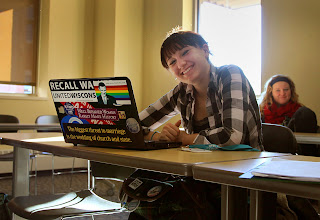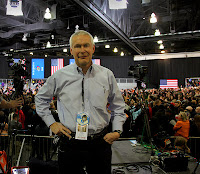 |
| [photo by Austen Keller] |
It is readily acknowledged that students are active users of social media. However, research has also shown the majority of students use social media for personal reasons, rather than for academic needs. In many academic circles, more discussion centers around the concern of faculty "friending" potential students or students attempting to "friend" faculty members. These issues seem to focus more on the policies of the potential impropriety of social media communication, rather than concentrating on how social media tools can be used to enrich and engage students and faculty in the teaching and learning process.
 |
Cristin Cesar learns how social media is used in politics
and human interest stories. [photo by Matt Davis] |
One method to create more awareness of the potential of social media tools, is to demonstrate their use in communicating "real world examples" in classroom lectures. This is exactly the strategy employed in a series of lectures for Communications Studies classes at UW-La Crosse. Faculty member, Pamela Morris, invited me into two of her classes to show how social media can: motivate the base, affect author attribution, disseminate information quickly, distribute fact and fiction, and how it can reinforce or change opinions.
 |
Breanna Levine listens on how social media was used in
Wisconsin politics throughout 2011. [photo by Austen Keller] |
By utilizing citizen reporting via CNN iReports, students could see how stories can be quickly disseminated and amplified through social media tools such as Facebook, Twitter, and YouTube. Results could be analyzed through analytical data. Students learned that iReporting can reach a wide variety of people worldwide in a matter of hours. While they understand that social media can transmit information quickly, students had no idea just how fast these tools could distribute messages, either as fact or fiction.
 |
| [photo by Peiqing (Shine) Chen] |
Each class seemed extremely engaged in seeing and discussing actual stories and footage of current news events. Some students learned that the media can present the news in a biased manner. They also thought more deeply about the importance of watching viewpoints from both sides of an issue. Whether the story has a political story line, or is more of a human interest story, the key to engagement is to personalize the experience so that the audience can more readily connect.






